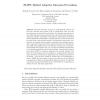114
Voted
ICISS
2010
Springer
14 years 11 months ago
2010
Springer
Abstract. Code injection attacks that target the control-data of an application have been prevalent amongst exploit writers for over 20 years. Today however, these attacks are gett...
100
Voted
DAC
2008
ACM
15 years 2 months ago
2008
ACM
Security of MPSoCs is an emerging area of concern in embedded systems. Security is jeopardized by code injection attacks, which are the most common types of software attacks. Prev...
122
click to vote
CCS
2008
ACM
15 years 3 months ago
2008
ACM
Harvard architecture CPU design is common in the embedded world. Examples of Harvard-based architecture devices are the Mica family of wireless sensors. Mica motes have limited me...
CCS
2007
ACM
15 years 5 months ago
2007
ACM
We present a framework to prevent code injection attacks in MS Windows using Native APIs in the operating system. By adopting the idea of diversity, this approach is implemented i...
110
click to vote
RAID
2005
Springer
15 years 6 months ago
2005
Springer
Intrusion detection systems are fundamentally passive and fail–open. Because their primary task is classification, they do nothing to prevent an attack from succeeding. An intru...
95
Voted
IWIA
2005
IEEE
15 years 6 months ago
2005
IEEE
This paper proposes a methodology to develop countermeasures against code injection attacks, and validates the methodology by working out a specific countermeasure. This methodol...
108
Voted
ACSAC
2005
IEEE
15 years 6 months ago
2005
IEEE
Code injection vulnerabilities continue to prevail. Attacks of this kind such as stack buffer overflows and heap buffer overflows account for roughly half of the vulnerabilities...
104
Voted
SRDS
2007
IEEE
15 years 7 months ago
2007
IEEE
Code injection attacks are a top threat to today’s Internet. With zero-day attacks on the rise, randomization techniques have been introduced to diversify software and operation...
110
Voted
DSN
2007
IEEE
15 years 7 months ago
2007
IEEE
Code injection attacks, despite being well researched, continue to be a problem today. Modern architectural solutions such as the NX-bit and PaX have been useful in limiting the a...
123
Voted
CODES
2007
IEEE
15 years 7 months ago
2007
IEEE
Multiprocessor SoCs are increasingly deployed in embedded systems with little or no security features built in. Code Injection attacks are one of the most commonly encountered sec...





